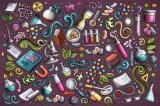This class is for students studying in 6th grade who want indepth knowlegde and clarity in concepts of the course.
Students will be learning the concepts of :
Chapter 1: Food: Where Does it Come from?
Food: Where Does it Come from? Students will learn about the different varieties of foods and their sources. This chapter also teaches about plant and animal products as food, categorisation of food based on the source of the food they eat
Chapter 2: Components of Food
This chapter deals with the components of food, constituents of different food items, tests to identify starch, protein and fat. This chapter will impart knowledge on the effect of different nutrients on our body, the meaning of a balanced diet. After studying these NCERT Solutions students will be able to attain knowledge of deficiency diseases.
Chapter 3: Fibre to Fabric
Chapter 3 has topics related to a variety of fabrics, fibres, plant fibers and spinning of cotton yarn. After studying this chapter, students will be able to get crucial insights into the process of making fabric from yarn together with the historical aspects of clothing.
Chapter 4: Sorting Materials into Groups
Sorting Materials into Groups will help students to know the objects around us, their properties, which include appearance, hardness, solubility, buoyancy and transparency.
Chapter 5: Separation of Substances
Separation of Substances will teach us separation methods such as handpicking, threshing, winnowing, sieving, sedimentation, decantation and filtration, evaporation. Students will also get a brief knowledge of the solubility and saturation of solubility in this chapter.
Chapter 6: Changes Around Us
NCERT Solutions for Class 6 Science Chapter 6 Changes around us will help you in perceiving reversible and irreversible nature of changes together with the ways of bringing changes around us, that we encounter daily.
Chapter 7: Getting to Know Plants
Getting to Know Plants is an interesting chapter that sheds light on herbs, shrubs and trees. This chapter introduces you to stem, leaf, root and flower. This chapter has many activities that will help you to get knowledge of plants and their parts.
Chapter 8: Body Movements
Body movements will acquaint us with the human body and its movements, which includes a brief introduction of ball and socket joints, pivotal joints, hinge joints, fixed joints. This chapter also has topics related to the gait of animals with examples of earthworm, snail, birds, fish and snakes.
Chapter 9: The Living Organisms and their Surroundings
The Living Organisms — characteristics and Habitats will help you grasp topics including surroundings that organisms live in, habitat and adaptation, different types of habitats and characteristics of living organisms.
Chapter 10: Motion and Measurement of Distances
Motion and Measurement of Distances is a very basic chapter that deals with transport, measurements, standard units of masurement, length measurement, measurement of the length of a curved line, movement of things around us and types of motions.
Chapter 11: Light, Shadows and Reflections
NCERT Solutions for Chapter 11 Light, Shadows and Reflections will help you in understanding concepts such as opacity, the meaning of shadows, pinhole camera and its construction. This chapter also includes topics of mirrors and reflections which is very important to understand thoroughly.
Chapter 12: Electricity and Circuits
Electricity and Circuits is an interesting chapter that teaches you about the electric cell, a bulb connected to an electric cell, meaning and construction of electric circuits, switches, conductors and insulators and their significance.
Chapter 13: Fun with Magnets
Fun with magnets will communicate the topics related to the discovery of magnets, magnetic and non-magnetic materials, poles of magnets, how to find directions using a magnet, making of magnets and concepts of attraction and repulsion between magnets.
Chapter 14: Water
Water is a very important chapter for it covers concepts like usage of water, sources of water, the meaning of water cycle, the formation of clouds, effects of heavy rainfall drought, conservation of water and rainwater harvesting
Chapter 15: Air Around Us
Air around us conveys the presence of air around us along with constituents of air, availability of oxygen to animals and plants living in water and soil and recycling of oxygen in the atmosphere.
Chapter 16: Garbage In, Garbage Out
Garbage in, Garbage out will put forward an understanding of dealing with garbage. This chapter briefs you about garbage disposal, recycling of paper, plastics, problems caused due to plastic.





